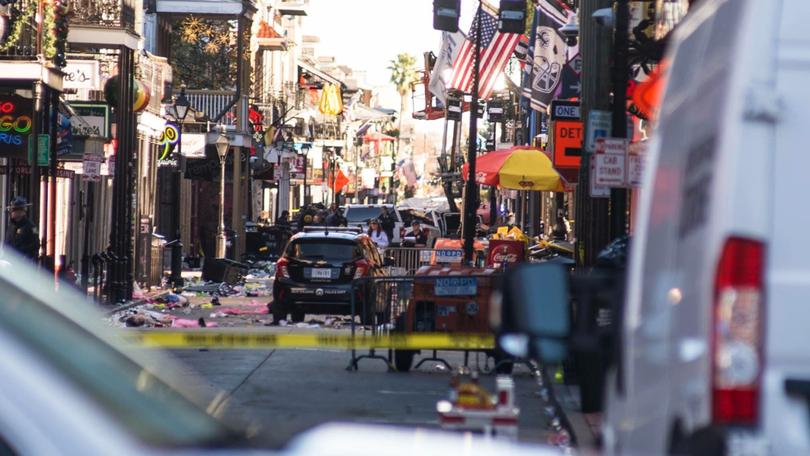New Orleans has revived the spectre of terrorism, but how vulnerable is Australia to attack?

The quick succession of horrific vehicle ramming attacks in a German Christmas market in December and a busy New Orleans street on New Year’s Day has rattled nerves about possible copycat attacks on Australian soil.
In the immediate aftermath of the deadly pickup truck rampage that killed at least 15 in the historic heart of New Orleans, Louisiana, the Government has confirmed Australia’s terrorism alert level will not be raised for now.
However, politicians, intelligence officials and extremism experts have urged the public to be aware of and stay vigilant to an ever-present and rapidly evolving threat of radicalisation that can trigger acts of mass violence.
Sign up to The Nightly's newsletters.
Get the first look at the digital newspaper, curated daily stories and breaking headlines delivered to your inbox.
By continuing you agree to our Terms and Privacy Policy.When contacted by the Nightly, the Australian Security Intelligence Organisation said the current national terrorism threat level was “probable,” according to their assessment there is a greater than 50 percent chance of a terrorist attack or attack planning in Australia in the next 12 months.
“ASIO assesses the most likely terrorist attack in Australia is an individual or small group moving to violence with little or no warning and using a readily available weapon such as a knife or vehicle,” the agency said in a statement.
The risk analysis was upgraded from “possible” to “probable” by Director-General Mike Burgess in August, during a speech where he warned the country’s “degrading” security environment is “more volatile and more unpredictable” amid an increase in extremism.
“More Australians are being radicalised, and radicalised more quickly,” he said.
“More Australians are embracing a more diverse range of extreme ideologies, and more Australians are willing to use violence to advance their cause.”
Conflict in the Middle East could be one factor potentially fuelling radicalisation, but the agency was anticipating an increase in politically motivated violence and terrorism “across all ideological spectrums,” Mr Burgess said.
“Attacks are likely to occur with little to no warning and will be difficult to detect,” he said, pointing to eight attacks or disruptions in the previous four months that either involved alleged terrorism or were being investigated as potential acts of terrorism.
These had offered insights about the existing nature of the counter-terrorism landscape — the threat from lone actors using rudimentary weapons such as knives, improvised explosives or a gun, as well as the acceleration of radicalisation that could lead to spontaneous violence.
It had also revealed a resurgence in the number of minors embracing violent extremism against a backdrop of online misinformation, and the diverse drivers of extremism that now ranged from radical ideology to grievances and personalised narratives.
But probable “did not mean inevitable,” he said, urging the public to “be aware, but not afraid.”
On Thursday, Patrick Gorman, the assistant minister to the Prime Minister, told Sky News the Government would “continue to take advice from US agencies as they investigate what potential links there are to … terrorist organisations when it comes to this attack in New Orleans.”
Chief suspect, Shamsud-Din Jabbar, 42, who careered his pickup through New Year’s revelers on Bourbon Street, a vibrant area in the famed French Quarter, was “inspired by” the Islamic State terrorist organisation, President Joe Biden said on Wednesday night.
In photos posted to social media shortly before the atrocity, the man indicated that he had a “desire to kill,” Mr Biden said in an address from Camp David.
Federal investigators are reportedly looking at his ties to the Islamic State after videos showing he had “pledged allegiance to ISIS.”
Mr Gorman urged Australians to “be on the lookout for potential things that don’t seem quite right,” to help the authorities keep the country safe.
James Paterson, shadow minister for home affairs, said the devastating alleged terrorist attack was a “sobering reminder of the ever-present threat of terrorism to western societies.”
In a statement on X, he added: “Our police, security and intelligence agencies have a critical ongoing task in thwarting attacks like this here at home.”
Dr Levi West, an expert in terrorism and radicalisation at ANU’s centre for social policy research, said violent extremism and terrorism remained a “persistent threat to Australian national security,” but that a notable recent change was the “diversification of ideological motivations.”
Threats had extended from jihadist-inspired operations to now include significant risks from the extreme right, or other causes like involuntarily celibate individuals, known commonly as incels, he told the Nightly.
“It’s more challenging and more complex than it was for the vast majority of the period of the war on terror,” he said.
“And it’s happening at a time when the national security agenda and counter terrorism is competing with other things, including nation-state-based threats like China, and when resources are being expended to support the war in Ukraine.”
Dr West assessed that jihadism still consistently accounted for more than 50 per cent of Australia’s onshore high priority counter-terrorism operations, but that the extreme right had nudged some 40 per cent of that workload.
He did not anticipate a dramatic increase, or decrease, in the threat to national security.
“There’s nothing to suggest or indicate that we would see a significant change to the threat assessment or a significant change to the threat that Islamic State presents,” he said, arguing that Australia and its Five Eyes allies were now seasoned at handling the dangers posed by jihadism.
Islamic State, while it had fallen off the front pages since the horrors and defeat of its would-be Caliphate in Iraq and Syria from 2014-19, had never disappeared, but simply moved its “centre of gravity” to less strategically important areas of the world like North Africa.
“Ideology itself is exceptionally challenging..you can’t kill ideas,” he said.
From its outset, Islamic State urged its supporters to engage in lone wolf-style terrorist attacks using tactics like vehicle crashes and stabbings in the West.
In January 2024, an ISIS audio message repeated a call to revive such attacks on Westerners, reported the Middle East Media Research Institute.
However, Dr West did not predict a similar spike in Islamic-State vehicle ramming to the terrorism campaign of 2015-2016.
In 2016, the world was horrified when a 19-tonne cargo truck deliberately struck down crowds celebrating Bastille Day in Nice, France, killing 86. Islamic State claimed responsibility.
In another deadly vehicle-borne terrorist attack in 2017, a white supremacist mowed down peaceful protesters in Charlottesville, Virginia.
In the wake of such attacks, most developed countries had rolled out a variation of Australia’s “crowded places strategy” in major metropolises, said Dr West.
“That means bollards as part of the security architecture for most public spaces,” he said.
There was nothing to suggest the kind of ideological catalyst that could lead to a spate of copycat incidents, he added.
In a tragic twist in New Orleans, officials confirmed that security bollards designed to prevent vehicles from hitting pedestrians were not present as they were being replaced in the run up to the city hosting next month’s Super Bowl.

